Read the CAN press release on expectations from the IPCC Synthesis Report
Read CAN’s letter to Governmental IPCC Focal Points
Civil Society representatives react to the IPCC Synthesis Report

Latest updates
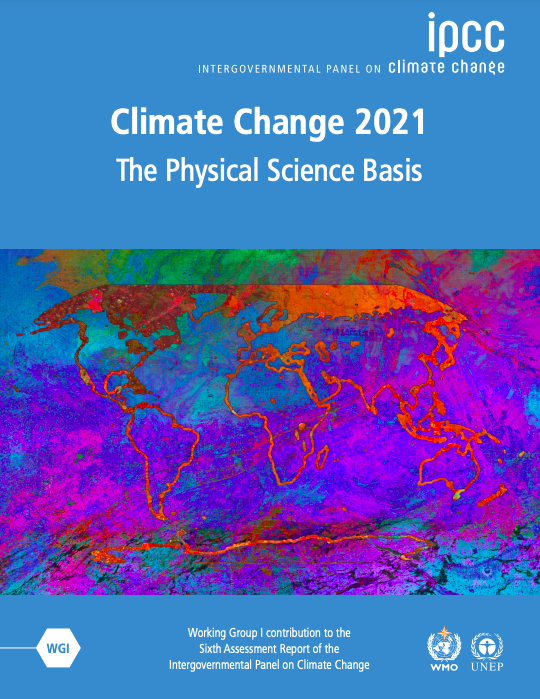
Working Group I Report: The Physical Science Basis
The report states with certainty that unprecedented human influence is wrecking the climate system, causing permanent and, in some instances, irreversible damage. Without urgent and far-reaching climate action, the world is on a razor’s edge with regards to breaching major tipping points. The window of time to stop warming beyond 1.5°C is rapidly closing in.
Some key findings from the report:
- The overall pace and scale of changes is unprecedented in all of human history. Presently the world is facing the highest CO2 concentration in atmosphere and the strongest ocean acidity in at least the last two million years caused primarily by burning fossil fuels during the last 200 years.
- Climate risk increases as we keep adding carbon dioxide to the atmosphere, and the impacts are exponential and not linear. These include rapid ocean surface water warming and the rate of ice sheet loss that increased by a factor of four between 1992–1999 and 2010–2019. Based on global warming from mainly CO2 emissions the average rate of sea level rise was 1.3 mm per year between 1901 and 1971, increasing to 1.9 mm per year between 1971 and 2006, and further increasing to 3.7 mm per year between 2006 and 2018.
- As tipping points with the fragile ice sheet dynamics cannot be ruled out, under high CO2 emissions, sea level rise might be 2 meters by 2100 and even 5 meters by 2150.
- Every 1°C warmer air takes up 7% more water that in the end intensifies the amount of precipitation.
- We’re making extreme weather events more intense and, for some, more frequent as higher global warming increases the probability of high impact outcomes.
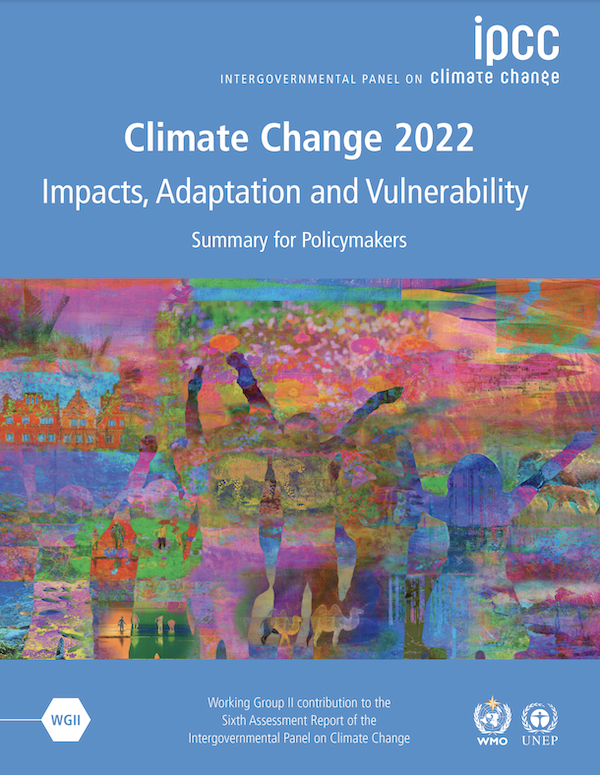
Working Group II Report: Impacts, Adaptation and Vulnerability
The IPCC has finalized the second part of the Sixth Assessment Report, Climate Change 2022: Impacts, Adaptation and Vulnerability, the Working Group II contribution to the Sixth Assessment Report. It was finalized on 27 February 2022 during the 12th Session of Working Group II and 55th Session of the IPCC.
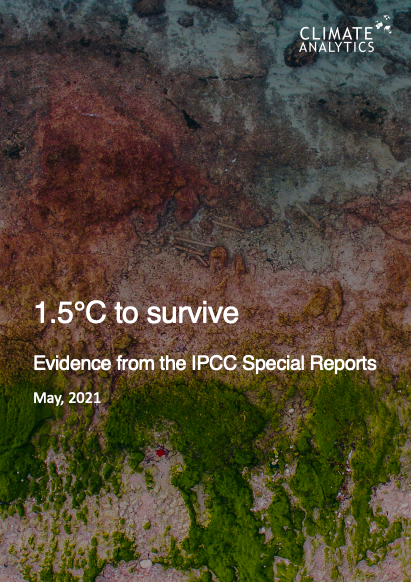
1.5°C to survive. Evidence from the IPCC Special Reports
These briefings summarise the impacts of global warming at and above 1.5°C relative to pre-industrial levels. Key information is extracted from the Special Reports of the Intergovernmental Panel on Climate Change (IPCC) of its sixth assessment report cycle (AR6). These Special Reports are:
- The Special Report on the Impacts of Global Warming of 1.5°C (SR1.5) from 2018, and
- The Special Report on Climate Change, Desertification, Land Degradation, Sustainable Land Management, Food Security, and Greenhouse Gas Fluxes in Terrestrial Ecosystems (SRLand) from 2019.
- Special Report on the Ocean and Cryosphere in a Changing Climate (SROCC) from 2019.
These Special Reports represent an invaluable resource to understand the impacts of exceeding 1.5°C and new science published after their compilation has only contributed to an ever clearer picture of the grave consequences of exceeding that limit. In addition to the overview on climate impacts based on the Special Reports, latest information on global mitigation efforts and requirements to meet the 1.5°C limit are also included.
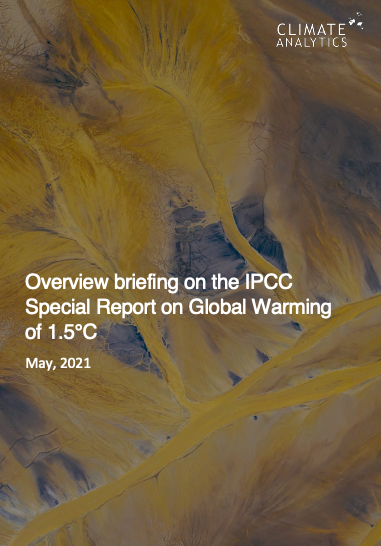
SUMMARY
The 1.5°C limit means we can avoid the worst of the climate crisis
The IPCC Special Reports SR.15 and SRLand are clear: limiting warming to 1.5°C can avoid the worst impacts of climate change. Compared to 2°C of warming, 1.5°C would see much less severe extreme events, for example mid-latitude heat waves would be 1°C colder on average. There would also be fewer disruptions to human and ecological systems – crop yield change would affect 158 million fewer people. Limiting warming to 1.5°C means substantially fewer people would be impacted by water scarcity, lack of food security and extreme poverty.
The 1.5°C warming limit is still within reach
Limiting warming to below 1.5°C is still possible but requires very urgent and rapid action now. Stringent emission reductions need to take place in the very near-term to halve current projections for 2030 CO2 emissions. 1.5C pathways require CO2 emissions to peak now and reach net zero by mid-century, with total greenhouse gases quickly following suit in the second half of this century.
Are we on track for 1.5°C?
The world is not on track for 1.5°C and most countries still lack sufficient climate targets. Recent updates to national climate targets presented at the US Climate Leaders’ Summit are a step forward to limiting warming to 1.5°C. The Climate Action Tracker calculates that the impacts of these updates reduce estimated end of century warming to 2.4°C, meaning we are closer to the 1.5°C temperature goal than ever before. These recent updates to national targets have reduced the emissions gap (the gap between current policy projections’ 2030 emissions and a 1.5°C trajectory) – by 11-14% (2.6-3.9 GtCO2e). However, a large gap of 20-23 GtCO2e remains.
BRIEFINGS
Read the briefings produced from the IPCC Special Reports:

The Science of Temperature Overshoots: Impacts, uncertainties and implications for near-term emissions reductions
Climate science uses emission pathways to assess different trajectories towards limiting warming to dedicated warming levels, most commonly to below 1.5°C or 2°C. In recent years, so-called overshoot pathways have also increased in prominence. In overshoot pathways global mean temperatures temporarily exceed a specific target, such as 1.5°C, before bringing temperatures back down below.
The technologies that are currently suggested to support this temperature drawdown are summarised under the term carbon dioxide removal (CDR). While some potential for sustainable CDR deployment exists, reliance on CDR at a large scale comes with its own risks, uncertainties and side-effects. This report provides an overview of the science on overshoot pathways and its implications.

1.5°C: A Tipping Point for the Arctic
The Arctic is home to approximately four million people from over 40 different ethnic groups, living across three continents and eight countries. It provides habitat to an abundance of endemic species including iconic species like the Polar Bear and the Walrus.
The physical processes within the Arctic region are key components of the global climate system. However, the entire region is subject to the most rapid and extreme climate change worldwide.
This briefing will summarise some of the observed and projected impacts on the physical, biological, and human dimensions as outlined by the most recent IPCC reports. It will also take a look at different possible responses and link to the latest research beyond the IPCC assessment.
- 1.5°C: A Tipping Point for the Arctic (April 2022)
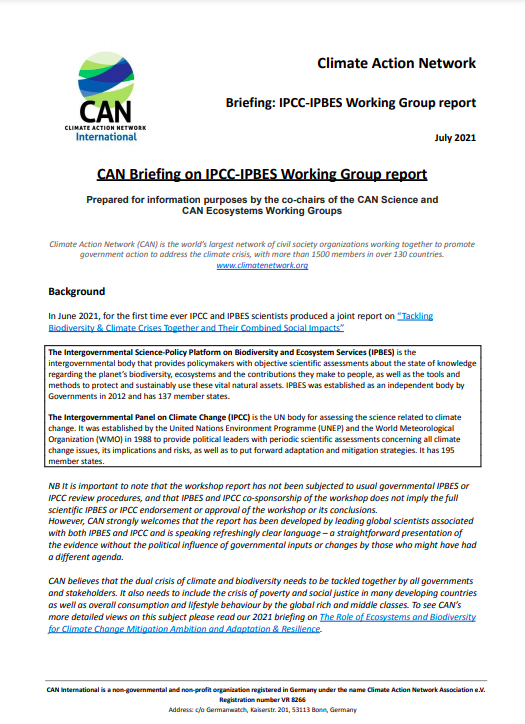
CAN briefing on IPCC-IPBES Working Group report
In June 2021, for the first time ever IPCC and IPBES scientists produced a joint report on “Tackling Biodiversity & Climate Crises Together and Their Combined Social Impacts”
CAN believes that the dual crisis of climate and biodiversity needs to be tackled together by all governments and stakeholders. It also needs to include the crisis of poverty and social justice in many developing countries as well as overall consumption and lifestyle behaviour by the global rich and middle classes. To see CAN’s more detailed views on this subject please read our 2021 briefing on The Role of Ecosystems and Biodiversity for Climate Change Mitigation Ambition and Adaptation & Resilience.
CAN supports the proposal by several countries to protect up to 50% of all land and oceans in a sustainable, participatory and democratic manner by 2030 to allow for recovery of biodiversity and natural carbon sequestration potentials. CAN urges in addition that all remaining land and oceans must be restored and managed in a sustainable, precautionary, ecological way for all species, peoples and the natural ecosystems.

